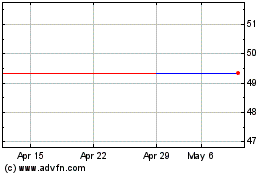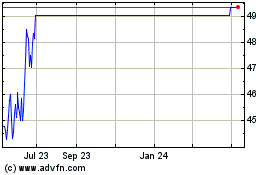Bar-Code Readers Get Makeover to Spur Bustling Warehouses
January 07 2016 - 5:59AM
Dow Jones News
By Loretta Chao
Scanner guns--the bar-code readers used in warehouses
world-wide--are getting a makeover, as retailers scramble to boost
productivity amid a surge in online orders.
From "rings" that workers wear on their hands to modified
smartphones, companies are testing alternatives to the "brick on a
stick" scanners that have been the industry standard for
decades.
The goal: shave a few precious seconds off the time it takes for
workers to select, pack and ship items. Warehouse workers use
scanners thousands of times a day. Retailers rely on the devices to
keep track of hundreds of thousands of goods stored in, and moving
around, massive distribution centers.
Zebra Technologies Co., the biggest maker of scanners, is
betting on a new version of its gun that eliminates the need for
warehouse employees to continuously extend their arms or rotate
their wrists. Zebra, which is based in Lincolnshire, Ill., says the
baton-like device, which features a touch screen and camera, will
increase scanning speed and reduce stress on workers' arms. The
company, which acquired scanner maker Motorola Solutions Inc. in
2014 and also makes printers, plans to roll out its new device on
Thursday.
James Bonner, general manager of Exel Logistics, a unit of
Deutsche Post DHL, said his employees make roughly 3,000 scans each
during a 7.5-hour shift. He said that in a three-month test of
Zebra's new device his employees had 10% to 20% improvement in
picking rates--or the speed of assembling orders--in part because
they no longer had to push buttons.
"In the big scheme of the world, it sounds like nothing," Mr.
Bonner said. "But when you take away three [button] touches, that's
like three halves of a second. And you're shipping thousands of
shipments a day."
Retailers and others that sell online, as well as logistics
companies, are hungry for new ways to improve efficiency to counter
the added labor and transportation costs associated with filling
online orders. Competition from e-commerce giant Amazon.com Inc. on
both price and speed has forced them look for any possible way to
cut costs and shorten delivery times, experts say. The most
sophisticated of these companies already analyze the movements of
their employees down to minute details.
Global sales of mobile scanning devices used in warehouses
reached about $850 million in 2015, up 33% since 2013, according to
VDC Research.
"The explosion of e-commerce has really driven the market need
for investment in data capture solutions," said Richa Gupta, an
analyst at the firm.
At the same time, more ergonomic design would help warehouse
workers, who are pushed to their limits handling the ballooning
order volume, said Regenia Sanders, a supply-chain consultant with
SSA & Co.
Warehouse workers can suffer from carpal-tunnel syndrome and
other injuries from repetitive movement. The transportation and
warehousing industry has the highest rate of occupational injuries
and illnesses among private-sector industries, according to the
U.S. Bureau of Labor Statistics.
The new Zebra TC8000, which will list for $2,895 and up, runs
software powered by Google Inc.'s Android and is controlled by a
large touch screen, rather than the buttons typically found on
scanners guns. It is designed so that the handle is the heaviest
part of the device, allowing users a wider range of wrist movement
than with top-heavy scanner guns. A camera lets users see items as
they scan them, to prevent mistakes, and helps them navigate
warehouse aisles.
Zebra leads an increasingly crowded market for scanning devices,
including lower-cost solutions that rely on smartphones. But many
retailers have stuck to industrial scanner guns, in part because
they are rugged enough to withstand wear and tear and can scan
faster, analysts say.
John McCranor, vice president of warehouse operations at
Lifetime Brands Inc., which ships KitchenAid and Mikasa-branded
household products directly to online shoppers from a warehouse in
New Jersey, said shaving even a second off the picking or packing
process is a priority. Over the past year, he started using ring
scanners to help keep pickers' hands free to carry more product at
once. The rings increase picking speed by 40%, he said, but cost
about $6,500 each, almost double the price of a gun scanner.
"Most of our growth was in the e-commerce business. It's more
labor intensive," he said. Picking speed is "a huge consideration
and issue."
Write to Loretta Chao at loretta.chao@wsj.com
(END) Dow Jones Newswires
January 07, 2016 05:44 ET (10:44 GMT)
Copyright (c) 2016 Dow Jones & Company, Inc.
Deutsche Post (PK) (USOTC:DPSGY)
Historical Stock Chart
From May 2024 to Jun 2024

Deutsche Post (PK) (USOTC:DPSGY)
Historical Stock Chart
From Jun 2023 to Jun 2024
